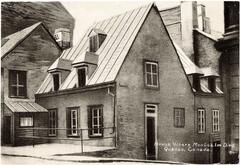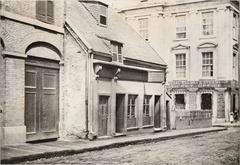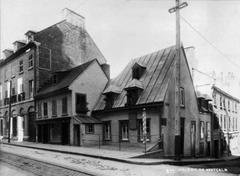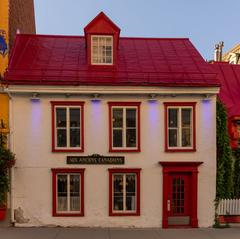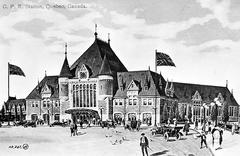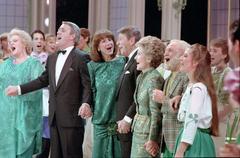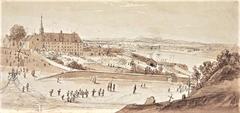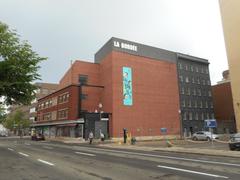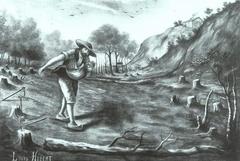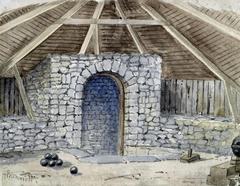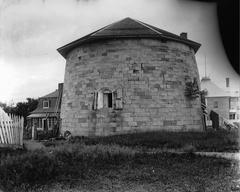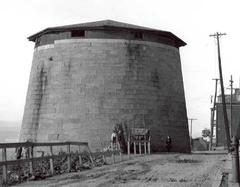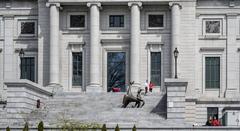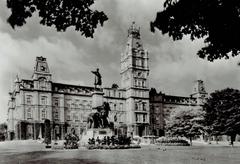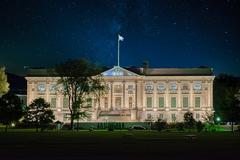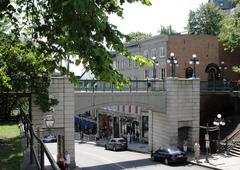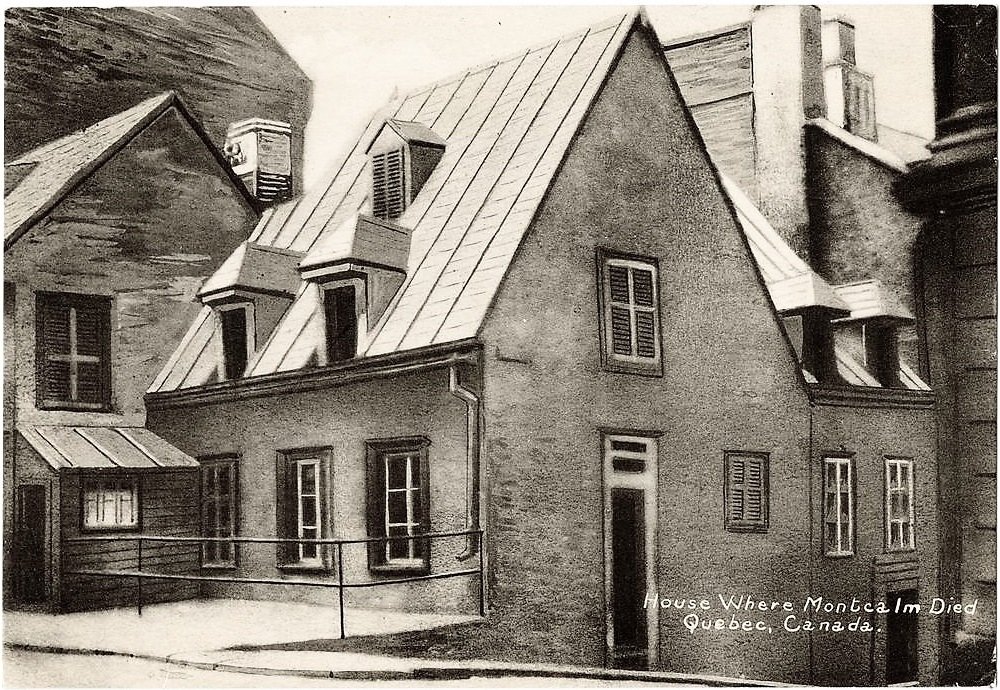
Maison François-Jacquet-Dit-Langevin: Visiting Hours, Tickets, and Historical Significance Guide
Date: 14/06/2025
Introduction
Nestled in the UNESCO World Heritage district of Old Quebec, the Maison François-Jacquet-Dit-Langevin is a remarkable testament to more than 300 years of French colonial architecture and Quebec City’s evolving urban landscape. As one of the province’s oldest surviving residences, it invites visitors to explore the layered history of New France. The house’s thick stone walls, steep roof, and period interiors reveal the craftsmanship and adaptation of early settlers, while its association with notable figures like François Jacquet dit Langevin and Philippe Aubert de Gaspé enriches its cultural legacy. Today, it serves both as a heritage site and as the home of the celebrated restaurant Aux Anciens Canadiens, providing an immersive experience that fuses history, architecture, and cuisine (histoire-du-quebec.ca, grandquebec.com, quebec-cite.com).
Table of Contents
- Introduction to Maison François-Jacquet-Dit-Langevin
- Origins and Construction (1675–1690)
- Architectural Evolution and Restoration
- Interior Features and Craftsmanship
- Ownership and Cultural Connections
- Heritage Designation and Preservation
- Visitor Information: Hours, Tickets, and Accessibility
- Visitor Experience and Tips
- Nearby Attractions
- Frequently Asked Questions (FAQ)
- References
Origins and Early Construction (1675–1690)
The house’s origins date to 1674, when the Ursuline nuns granted the land to François Jacquet dit Langevin, a master slate roofer crucial to Quebec’s early development. Initially a wooden structure built by Pierre Ménage, the house was soon rebuilt in stone around 1690 by surveyor François de Lajoüe, reflecting the shift to more permanent, fire-resistant construction as the city grew (histoire-du-quebec.ca). The original design featured thick masonry, a steeply pitched gable roof, and small, deeply recessed windows—hallmarks of French colonial adaptation to the region’s severe climate.
Architectural Evolution and Restoration
Over the centuries, Maison François-Jacquet-Dit-Langevin underwent several expansions. In 1795, a stone annex with a large kitchen hearth was built, creating the building’s characteristic L-shape. Further additions in the early 19th century included a new wing, which was raised to two stories in 1898 as part of urban improvements on rue Saint-Louis. These changes, while modernizing the house, retained its essential historical character (grandquebec.com).
A major restoration in 1958, led by architect André Robitaille, preserved the house’s historic fabric and adapted it for its current use as a restaurant. Efforts focused on using authentic materials and techniques, ensuring the building remains a rare survivor of its era (Commons: Maison François-Jacquet-Dit-Langevin).
Interior Features and Craftsmanship
Inside, visitors can admire original elements such as coffered paneling, exposed wooden beams, built-in cupboards, and stone fireplaces. The layout is typical of 18th-century urban homes, with a central hallway and rooms on either side. Floors of wide-plank pine or oak and wrought-iron hardware on doors and windows showcase the craftsmanship of New France’s artisans. These features, combined with thick stone walls and deep sills, provide both comfort and a tangible link to the past (grandquebec.com).
Ownership and Cultural Connections
The house’s history is intertwined with prominent Quebecois figures. François Jacquet dit Langevin was instrumental in the city’s early construction. Later, his son-in-law, François de Lajoüe, a noted builder and surveyor, contributed to the property’s expansion. In the 19th century, the house was owned by Philippe Aubert de Gaspé, author of “Les Anciens Canadiens.” While he did not reside there, his literary association is commemorated by the restaurant that now occupies the site (grandquebec.com). Local legend once claimed the Marquis de Montcalm died here after the 1759 battle, a tale now debunked but indicative of the house’s place in Quebec’s collective memory.
Heritage Designation and Preservation
Maison François-Jacquet-Dit-Langevin was classified as a historic monument in 1957 and is a contributing property within the UNESCO World Heritage district of Old Quebec (Ville de Québec). Its preservation ensures that future generations can appreciate the architecture and narratives of Quebec City’s colonial era. Restoration and maintenance efforts continue to balance historical integrity with modern use.
Visitor Information: Hours, Tickets, and Accessibility
Location: 34–36 rue Saint-Louis, Quebec City, QC, Canada
Visiting Hours:
- The house is not open for standard public tours.
- The restaurant Aux Anciens Canadiens is open daily for lunch and dinner, typically 11:30 AM to 9:00 PM. Hours may vary seasonally; check the restaurant’s official website or call ahead.
Tickets and Admission:
- No admission fee to view the exterior or enter the restaurant.
- Reservations for dining are strongly recommended, especially during peak seasons.
Accessibility:
- Due to its historic nature, accessibility is limited. Entrances and restrooms may not be fully wheelchair accessible. Contact the restaurant in advance for assistance.
Photography:
- Exterior photography is encouraged. Interior photography is subject to restaurant policy.
Visitor Experience and Tips
- Dining: Enjoy traditional Quebecois cuisine in an atmospheric setting that retains many historical features.
- Tours: Walking tours of Old Quebec often include commentary on the house’s history. Book with reputable local operators for the best experience.
- Seasonal Highlights: The area is especially picturesque in winter, with festive lights and snow.
- Travel Tips: Wear comfortable shoes for cobblestone streets. English is widely spoken, but French enhances the experience.
Nearby Attractions
Maison François-Jacquet-Dit-Langevin is an excellent starting point to explore Old Quebec’s rich history. Key sites within easy walking distance include:
- Château Frontenac
- Place d’Armes
- Holy Trinity Cathedral
- Dufferin Terrace
- Petit-Champlain District
- The Fortifications of Quebec
- La Citadelle (quebec-cite.com)
Frequently Asked Questions (FAQ)
Q: Can I visit the interior without dining at the restaurant?
A: No. Interior access is available to restaurant guests only.
Q: Are guided tours available inside?
A: Formal guided tours are not offered, but staff may share historical insights. Many walking tours include the house as a stop.
Q: Are there ticket fees?
A: No. Dining is at guests’ expense; there is no separate admission fee.
Q: Is the site wheelchair accessible?
A: Accessibility is limited due to the building’s historic design. Contact the restaurant for specific needs.
Q: How do I make reservations?
A: Book directly with Aux Anciens Canadiens via their website or by phone.
Visual and Interactive Resources
Summary and Travel Tips
Maison François-Jacquet-Dit-Langevin is a cornerstone of Quebec City’s living heritage, melding original 17th-century construction with later modifications. Its story reflects the city’s architectural evolution, its preservation underscores Quebec’s reverence for its colonial past, and its ongoing function as a restaurant allows visitors to experience its ambiance firsthand. While interior access is limited to diners, the exterior and location in Old Quebec provide ample opportunities for exploration and photography. Combine your visit with other nearby historical sites and consider guided tours for deeper insights. For the latest information on dining hours, events, and accessibility, consult official tourism resources and the restaurant’s website (histoire-du-quebec.ca, grandquebec.com, quebec-cite.com).
References
- Maison François-Jacquet-Dit-Langevin: histoire-du-quebec.ca
- GrandQuebec.com – François Jacquet dit Langevin
- Quebec-Cite.com – Old Quebec Attractions
- Ville de Québec – Official Heritage Page
- Commons: Maison François-Jacquet-Dit-Langevin
- Toponymie Québec
For further information, visit the official Quebec City tourism website.
